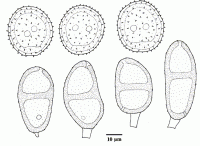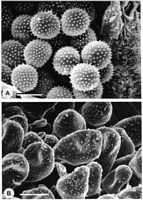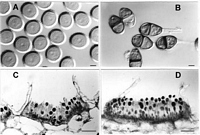|
 Puccinia embergeriae Puccinia embergeriae
BiostatusPresent in region - Indigenous. Endemic
Images (click to enlarge)
Caption: Fig. 1 Puccinia embergeriae, urediniospores (upper) and teliospores (lower) of the
type (PDD 62047). Specimen mounted in hydrous lactophenol. | 
Caption: Fig. 2 Puccinia embergeriae. A, Urediniospores; B, Teliospores. PDD 62047 (type). Scale bars = 20 mm. | 
Caption: Fig. 3 Puccinia embergeriae. A, Urediniospores; B, Teliospores; C, D, Transverse
sections of uredinia. PDD 62047 (type). Scale bars: A, B = 10 mm; C, D = 100 mm |
Article: McKenzie, E.H.C.; Johnston, P.R. (2004). Puccinia embergeriae sp. nov. on Chatham Islands sow thistle (Embergeria grandifolia) and a note on Miyagia pseudosphaeria on sow thistles (Sonchus spp.) in New Zealand. New Zealand Journal of Botany 42(4): 657-661 (http://www.rsnz.org/publish/abstracts.php).
Description: Aecia not known. Uredinia mainly hypophyllous, golden-brown, bullate, later
pulverulent, up to 1.5 mm diam., with a few peripheral paraphyses. Urediniospores
(28-)30-33(-34) x (25.5-)26.5- 29.5 µm, subglobose or broadly ellipsoid, wall 2-
layered, outer layer 1-1.5(-2) µm thick, hyaline, inner layer 2-2.5(-3) µm thick, pale
yellow, echinulate, germ pores 2, equatorial, contents pale yellow. Telia mainly
hypophyllous, initially arising from the same sori as the uredinia, blackish brown,
bullate, later pulverulent, up to 1.5 mm diam. Teliospores (30-)32-40(-50) x
(21-)22.5-26 µm, ellipsoid or oblong ellipsoid, sometimes slightly constricted at
septum, wall 2-2.5 µm thick at sides, 2.5-4 µm at apex, verrucose, golden brown,
contents pale brown, pore in upper cell apical or nearly so, pore in basal half of lower
cell; pedicel usually breaking near hilum, but sometimes up to 65 x 4-5 µm, hyaline.
Habitat: HOST: Embergeria grandifolia (Kirk) Boulos (Chatham Islands sow thistle).
Notes: ETYMOLOGY: From the host plant.
NOTES: Several rusts, including species of Coleosporium, Miyagia, and Puccinia,
have been described or recorded from Sonchus, but only one rust, the widespread
Miyagia pseudosphaeria (Mont.) Jørst., has been recorded in New Zealand on
Sonchus (Cunningham 1924). Puccinia embergeriae is quite distinct from M.
pseudosphaeria, which is distinguished by possessing a peripheral, palisadelike layer
of brown, thick-walled paraphyses in both the uredinia and telia; such paraphyses are
lacking in P. embergeriae. In addition, the urediniospores of M. pseudosphaeria are
generally narrower, with 3- 4 germ pores. Parmelee & Savile (1981) gave an account
of North American Puccinia species on members of the Lactuceae (syn. Cichorieae).
Of the species treated, P. hieracii, which has been recorded in New Zealand, has a
wide host range within the Lactuceae. However, the urediniospores of P. hieracii have
a tonsure, or smooth area, below each germ pore, a feature not observed in P.
embergeriae.
Embergeria grandifolia is a threatened plant, and is listed as a nationally endangered
species i Hitchmough (2002). Puccinia embergeriae, which is an obligate parasite,
probably co-exists with its host plant. However, it is also a threatened species,
classified as nationally critical (Hitchmough 2002).
When viewed with the scanning electron microscope, the urediniospores of P.
embergeriae appeared to be smaller than when viewed by light microscopy.
Measurements were checked and it is concluded there is significant shrinking of these
spores when placed in the electron microscope. At high magnification, wrinkling of
the spore surface between the spines was evident.
|